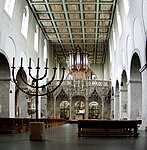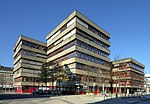Richard-Riemerschmid-Berufskolleg
Buildings and structures in CologneEducation in CologneGerman school stubsHigh schools in GermanyNorth Rhine-Westphalia building and structure stubs
The Richard-Riemerschmid-Berufskolleg is a secondary school in the southern half of the German city of Cologne. It is notable for being named after the architect and designer Richard Riemerschmid.
Excerpt from the Wikipedia article Richard-Riemerschmid-Berufskolleg (License: CC BY-SA 3.0, Authors).Richard-Riemerschmid-Berufskolleg
Heinrichstraße, Cologne Altstadt-Süd (Innenstadt)
Geographical coordinates (GPS) Address Phone number External links Nearby Places Show on map
Geographical coordinates (GPS)
| Latitude | Longitude |
|---|---|
| N 50.927597 ° | E 6.952438 ° |
Address
BK Richard-Riemerschmid-Berufskolleg
Heinrichstraße 51
50676 Cologne, Altstadt-Süd (Innenstadt)
North Rhine-Westphalia, Germany
Open on Google Maps








